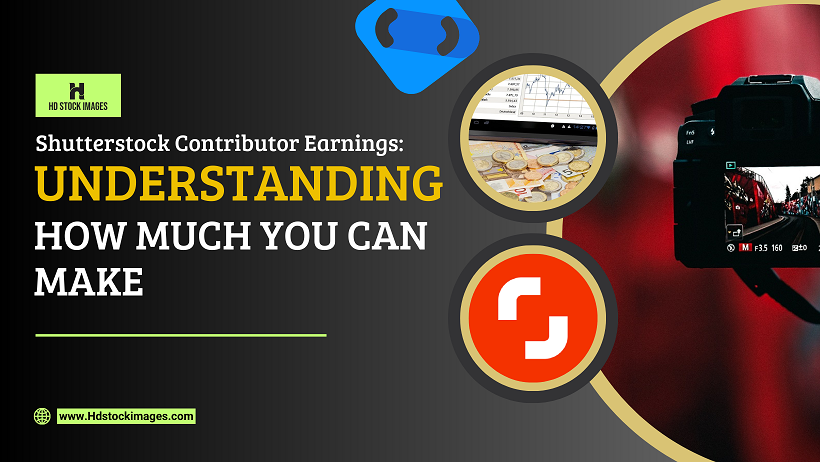1. Introduction
Aspiring photographers and artists often seek opportunities to monetize their creative work. Shutterstock, a popular stock photography platform, offers a platform for contributors to showcase and sell their images. However, understanding the earning potential on Shutterstock is crucial for contributors looking to turn their passion into a sustainable income stream. In this blog post, we will explore the factors that influence Shutterstock contributor earnings and provide insights on how to estimate and maximize your potential earnings on the platform. Whether you're a seasoned contributor or just starting out, gaining a better understanding of Shutterstock's earning model can help you make informed decisions and achieve success in your creative endeavors.Also Read This: How to Get Clients on Behance: Tips for Attracting Clients to Your Portfolio
2. How Shutterstock Contributor Earnings Work

A. Shutterstock operates on a royalty-based system
where contributors earn a percentage of the revenue generated from the sales of their images. When customers license your images, you receive a royalty based on the license type and the customer's subscription plan.Royalty System: Shutterstock offers different royalty levels based on the contributor's lifetime earnings on the platform. As your lifetime earnings increase, you progress through different levels, which can result in higher royalty rates.License Types: Shutterstock offers various license types for customers, including editorial, commercial, and enhanced licenses. Each license type carries a different price, and contributors earn a percentage of the revenue generated from each license.B. Factors Influencing Contributor Earnings:
Quality and Relevance of Content: High-quality, unique, and visually appealing images tend to attract more customers and generate more sales. Focus on creating visually compelling content that meets the technical and aesthetic requirements of Shutterstock.Demand and Popularity: The demand for specific types of images fluctuates over time. Understanding the current trends, market demand, and customer preferences can help you create content that is more likely to be licensed and generate earnings.Contributor Level and Experience: As you progress through different contributor levels on Shutterstock, you may gain access to exclusive benefits and higher royalty rates. Additionally, the experience gained by actively participating in the platform can help improve your content creation skills and increase your earning potential.Sales Volume and Customer Subscriptions: The number of sales your images generate and the customer subscription plans play a role in your earnings. More sales and customers with higher subscription plans can lead to increased revenue.By considering these factors, contributors can better understand how their earnings are influenced and make informed decisions to optimize their portfolio and increase their earning potential on Shutterstock.Also Read This: How to Share a Behance Project Link with Your Network
3. Estimating Potential Earnings on Shutterstock

A. Step-by-Step Guide to Estimating Earnings:
Assess Market Demand: Research the current trends and popular subjects in the stock photography market. Analyze the types of images that are in high demand and align your content creation accordingly.Calculate Royalties Based on License Types: Understand the royalty rates associated with each license type offered on Shutterstock. Calculate potential earnings based on the percentage of revenue you receive from each license type.Consider Factors Affecting Sales Volume: Take into account the factors that can influence your sales volume, such as the quality of your content, keywording, and discoverability. Higher sales volume can directly impact your earnings.Example Scenarios and Earnings Calculations: Create hypothetical scenarios based on different variables, such as the number of sales per month, average license type, and customer subscription plans. Calculate potential earnings based on these scenarios to get a rough estimate of your earning potential.B. Importance of Diversifying Your Portfolio:
Benefits of a Diverse Range of Content: Having a diverse portfolio with a wide range of subjects and styles increases your chances of meeting the diverse needs of customers. It allows you to tap into different market segments and maximize your earning potential.Explore Underserved Markets and Niches: Identify niches or subjects that are currently underserved or have less competition. By providing unique content in these areas, you can attract customers who are specifically searching for those types of images, potentially increasing your earnings.Maximizing Earning Potential through Variety: Experiment with different photography styles, subjects, and concepts to cater to various customer preferences. Offering a variety of content can help you reach a broader audience and increase the likelihood of licensing your images.By following these guidelines and considering various factors that impact earnings, you can estimate your potential earnings on Shutterstock more accurately. Additionally, diversifying your portfolio and exploring different niches can open up new opportunities and enhance your earning potential on the platform.Also Read This: How to Resize PDF Images
4. Tips for Maximizing Shutterstock Contributor Earnings
A. Emphasize High-Quality Content and Attention to Detail:
Improve Technical Aspects: Pay attention to technical aspects such as focus, lighting, and composition. Ensure that your images meet the technical requirements of Shutterstock, including resolution, file formats, and image size.Follow Guidelines: Familiarize yourself with Shutterstock's guidelines for content submission. Adhere to their requirements regarding model releases, property releases, and copyright considerations.B. Strategies for Optimizing Visibility and Discoverability:
Effective Keywording and Metadata: Use relevant keywords and descriptive metadata when uploading your images. Properly categorize and tag your content to make it easier for customers to find your images in search results.Keep Up with Trends: Stay updated with current trends, events, and seasonal demands. Tailor your content to align with popular topics and themes that are in demand. Utilize keyword research tools or browse Shutterstock's trending images to gain insights.C. Building a Strong Online Presence and Promoting Your Portfolio:
Leverage Social Media and Personal Websites: Use social media platforms, such as Instagram or Twitter, to showcase your work and direct potential customers to your Shutterstock portfolio. Consider creating a personal website or blog to further promote your images and establish your brandEngage with the Shutterstock Community: Participate in forums, discussions, and groups within the Shutterstock community. Engaging with fellow contributors and sharing insights can help you learn new strategies, gain exposure, and build connections.D. Regularly Update and Refresh Your Portfolio:
Continuous Content Creation: Keep creating and uploading new content regularly to expand your portfolio and maintain visibility. Fresh and up-to-date content increases your chances of attracting customers and generating sales.Monitor and Analyze Performance: Keep track of your image performance on Shutterstock. Analyze which images are selling well and which ones may need improvement. Use this data to inform your content creation and portfolio management strategies.By implementing these tips, you can maximize your earnings as a Shutterstock contributor. Consistently producing high-quality content, optimizing visibility and discoverability, building an online presence, and regularly refreshing your portfolio will help increase your chances of success on the platform.Also Read This: How Much Are Adobe Stock Images? (Different Sizes and Types)
5. Success Stories and Inspirational Examples
A. Share Success Stories of Contributors:
Story 1: John Doe - From Hobbyist to Full-Time Contributor: John Doe started as a hobbyist photographer and joined Shutterstock as a contributor. With dedication and a focus on niche subjects, he built a substantial portfolio. Over time, his images gained popularity, resulting in consistent sales. Today, John Doe is a full-time contributor, earning a substantial income from his Shutterstock portfolio.Story 2: Jane Smith - Leveraging Seasonal Trends: Jane Smith recognized the power of seasonal trends and capitalized on them. She created a series of captivating images related to holidays, celebrations, and special events. By aligning her content with the demand during specific periods, Jane saw a significant increase in sales and earnings, establishing herself as a successful contributor.B. Highlight Strategies or Approaches:
Strategy 1: Focus on Niche Markets: Some contributors have found success by specializing in specific niches. By becoming experts in a particular subject or genre, they attract a dedicated customer base seeking unique and specialized content. This targeted approach allows them to stand out and generate higher earnings.Strategy 2: Collaboration and Creative Partnerships: Several contributors have formed partnerships with other artists or photographers to create collaborative projects. By combining their talents and resources, they produce high-quality content that appeals to a broader audience. These collaborations often result in increased exposure and higher earnings for all parties involved.C. Provide Inspiration and Motivation:
Sharing success stories and highlighting different strategies serves as inspiration and motivation for aspiring contributors. It demonstrates that with dedication, creativity, and strategic approaches, it is possible to achieve significant earnings and turn their passion into a successful career on Shutterstock. These stories remind contributors of the potential rewards and encourage them to pursue their goals with determination.Remember, success on Shutterstock is not guaranteed, but by learning from successful contributors and adapting their approaches to your own unique style and content, you can increase your chances of achieving your earning goals and finding success on the platform.Adobe Stock vs. Shutterstock Earnings, all I'm saying is that one platform seems to be a lot more fair with their slip...granted royalties aren't what they should be on either platform...once just clearly is better. pic.twitter.com/a6WAwyBbb3
— Dominik Skorynko 🎥📸 (@DominikSkorynko) May 2, 2022

 admin
admin








